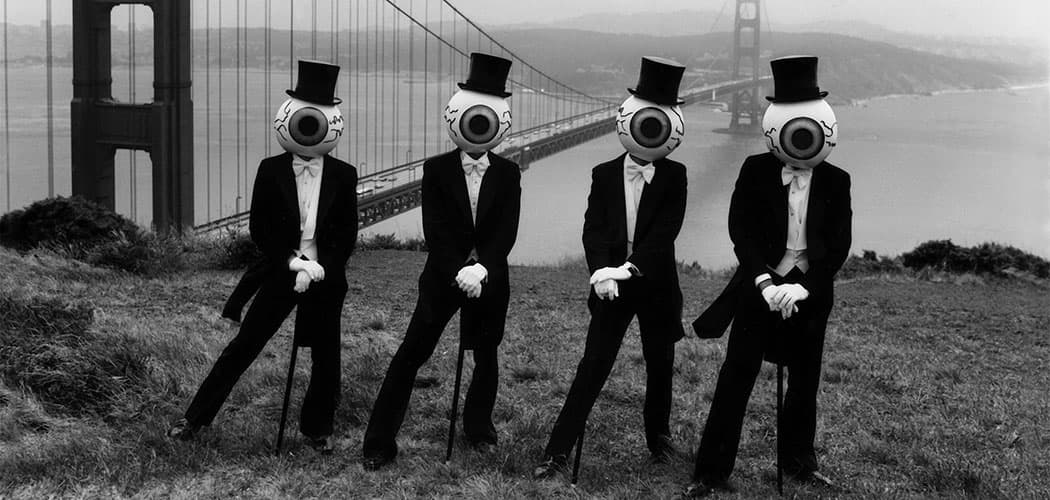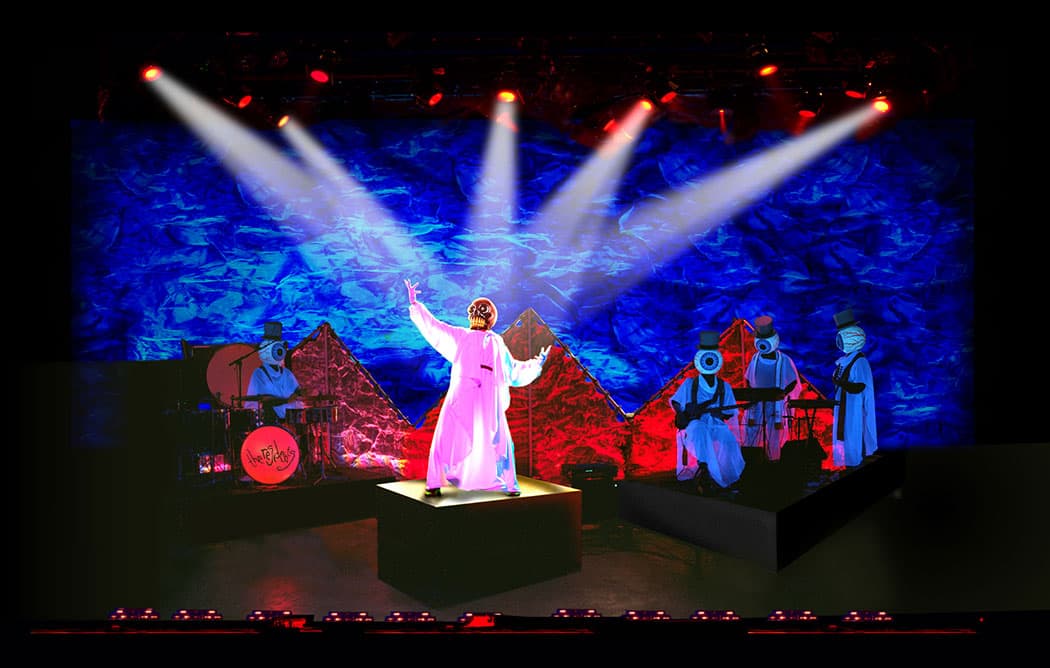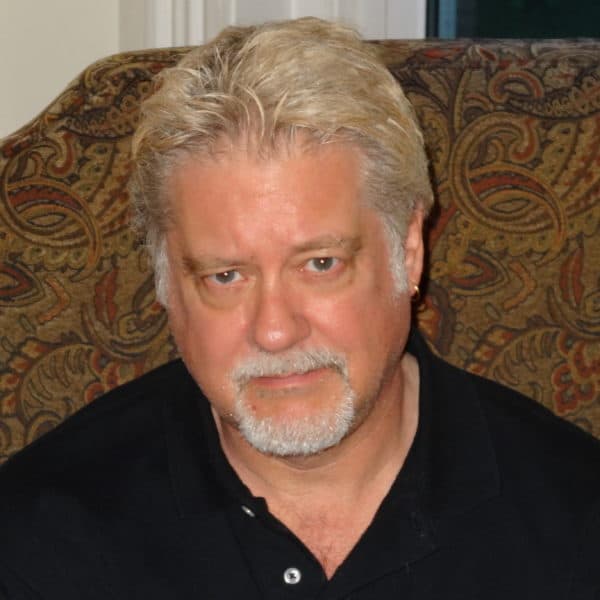Advertisement
At The Heart Of The Residents’ Cult Fame Is The Mystery: Who Are These Masked Rockers?

The Residents first landed in the rock music world in 1974 with an album called “Meet The Residents.” Aside from the crazy gang of masked rock ‘n’ rollers having fun with the “Meet The Beatles!” album title and design — with devilish, Dadaist doodling over the Beatles own — it has to still rank as the most ironic rock come-on of all time.
At the heart of their cult fame is the mystery of who they are. Even now with 100-plus CDs and LPs and numerous videos and CD-ROMs to their credit — few people outside of their inner circle and collaborators have truly “met” The Residents. Or, if they have met, they’ve maintained silence about exactly whom they’ve met.
Anonymity is the calling card of the avant-garde Residents, who perform in Boston at Royale April 25. They’re a group of musicians and performance artists who have always sported some sort of face-masking devices. Their most iconic costume is a giant, bloodshot eyeball-head with a tuxedo and top hat. It’s The Residents “looking” at us as we are looking at The Residents. They’re all-seeing, but impervious to emotional display.
As a musical entity, The Residents have spent a lifetime subverting, deconstructing, disemboweling, and re-contextualizing pop music, whether it be warped, twisted versions of The Beatles, Rolling Stones, Elvis Presley and James Brown songs, or through their own dark, oft-atonal compositions.
The Residents — minimalist in structure, ominous in tone — are not always in a full-on foul mood. There are offshoots of foul, such as cranky, agitated, aghast and, at their best, bemused. The Residents are a band that can strike you simultaneously as alluring and repellent, whimsical and malevolent.
The Residents are currently a singer, a guitarist and a drum programmer/special effects coordinator. And here’s the twist -- as if there needed to be another one -- the conceit this time is that The Residents are performing under the auspices of being “the world’s best Residents cover band.”
So explains Hardy Fox, who along with Homer Flynn, shares official spokesmen duties for the group. Officially, Fox and Flynn helm Cryptic Corp., founded in 1976, handle business and design aspects of The Residents. They claim to have nothing to do with the music-making/touring aspect of it.
Hardy explains the super-meta concept employed this time: “The band is Randy, Chuck and Bob -- although Chuck has retired. He’s not touring anymore, so he’s been replaced by Rico. The Residents had to reinvent themselves to survive and I think what we’ve got going on right now with this cover band approach is just another reinvention, another way of seeing The Residents and another way of them seeing themselves as what they may have been like if they had been a [traditional] band at the beginning.”
Advertisement
Fox says the group felt more like producers and multi-media artists when they started. If you had to call them anything musical, he adds, “They felt like they were more akin to jazz [musicians]. By doing covers they were able to explain to people how their sound was different than the original sound. The Residents became almost a ‘style’ rather than just a band playing a different song. You can’t really see that if it it’s original music, but you can really see if it’s a cover.”
The opening “act” at Royale will be a documentary, “Theory of Obscurity: a Film About The Residents,” written, directed and co-produced by Don Hardy. It starts with the members’ relocation from outside Shreveport, Louisiana, to San Francisco during the psychedelic ‘60s and follows them through the middle of this decade. The film drops hints about who The Residents may be -- or may have been -- but never quite lifts the veil.
“My first question to Don when he approached us,” says Fox, “was ‘How are you going to do a film about obscurity?’ I think he takes an approach to it, an angle that might be more compatible with a film audience. I think it misses, in some way, some of the darker aspects of The Residents, treats them as a happier product than perhaps they actually are.”
When Flynn was asked, via email, about The Residents’ identity and what takes place in “Theory of Obscurity,” he replied: “While everything has been hinted at or suggested, the identities of The Residents have never been revealed. The documentary changes nothing in that regard and easily allows anyone to believe exactly what they want. That having been said, the people who made ‘Meet The Residents’ are not exclusively the ones that will be on stage, and never have been.”
There are folks in the know who maintain that Flynn and Fox are The Residents, both the music makers and the business team. (As were two other original members who are no longer part of either process, both identified in the film by their business titles.)
Fox spent some time on the phone with me recently, speaking from The Residents’ San Francisco office, as the band was about to start rehearsal for their tour.
“As you see in the film, there are a lot of people interviewed and a lot of people are sitting there just lying away,” says Fox, chuckling slightly. “It’s amusing watching the film and seeing people have no problem about lying.”
So, I ask: Would that include you and Homer?
“Well, yeah, we’re the best at it, actually,” he says.
Four years ago, The Residents put out a box set, which held well over 100 different products including 40 vinyl LPs, 50 CDs and dozens of singles, EPs, DVDs and CD-ROMs plus other releases. Last year, New York’s Museum of Modern Art opened a permanent exhibit where all of those products are housed in an open-door, 28-cubic-foot refrigerator.
An honor?
“To be honest, I haven’t really thought about it that much,” says Fox. “There are people who just didn’t get it, but people should have gotten it and when somebody does get it, I think ‘It’s about time.’ I don’t bow down and say ‘Hooray! Hooray!’ It’s more like ‘What took you so long?’”

The Residents have long had a penchant for thematic albums and concerts. They centered one around Elvis, (“The King & Eye”) and another attempted to explain “The History of American Music in Three E-Z Pieces.”
Fox describes their current show “Shadowland” this way: “This is part three, the third show in this trilogy. The first one [2010’s “Talking Light”] was roughly about dying and old age, the second one [2013’s “Wonder of Weird”] tour was more about sex, and this is more about rebirth, about the ending as a beginning.”
“I don’t know that anybody has actually taken that away from any of these shows,” adds Hardy, with a slight laugh, “because it’s something that’s in the minds of The Residents.”
Fox’s comment about rebirth sounds (vaguely) uplifting, but the music … not so much. And Fox admits for “the series of shows, primarily all the material is about dying and death and old age. It’s OK. The Residents are getting older, too. It’s about themselves. It’s a complex undertaking.”
In concert, striking, if stark, staging and choreography has long been part of the package -- a mesh of music and stagecraft.
For “Shadowland,” Fox says, there is “none of this fancy ‘art’ stuff. It’s still very visual, but the visuals tend to be more within the realm of a standard rock show, working with lighting and video projections.”
In the realm of a rock show?
Fox clarifies: “It’s in the realm of rock shows, but not rock shows where people wear blue jeans. Rock shows where people wear costumes.”
A Residents show is not all darkness and foreboding. There will likely be moments that force a smile.
“I feel like the show is very up,” says Fox. “It’s gotten more upbeat and more almost danceable at times.”
(Keep in mind what Fox said earlier about him and Flynn being the best liars.)
“Humor is a very personal thing,” says Fox. “Certainly, what one person finds funny is not necessarily what someone else will find funny. The darkness in general is often a type of dark humor more than it is genuine darkness. They’re not really dark people, it’s more that they’re amused by it. So from that aspect, almost all of it is really humor, but none of it is really a joke. Life really is tragic. They do often take a humorous approach to dealing with the darkness that is out there.”
The song that closes the “Theory of Obscurity” film is an eerie, thumping number, “Marching to the See,” and it may explain The Residents’ peculiar passion best. The singer growls: “We have left our lives/We have left our land/We have left behind all we understand/ Now we must cry out as we make our stand/We will die pretending to be a band … Help us, help us please.”



